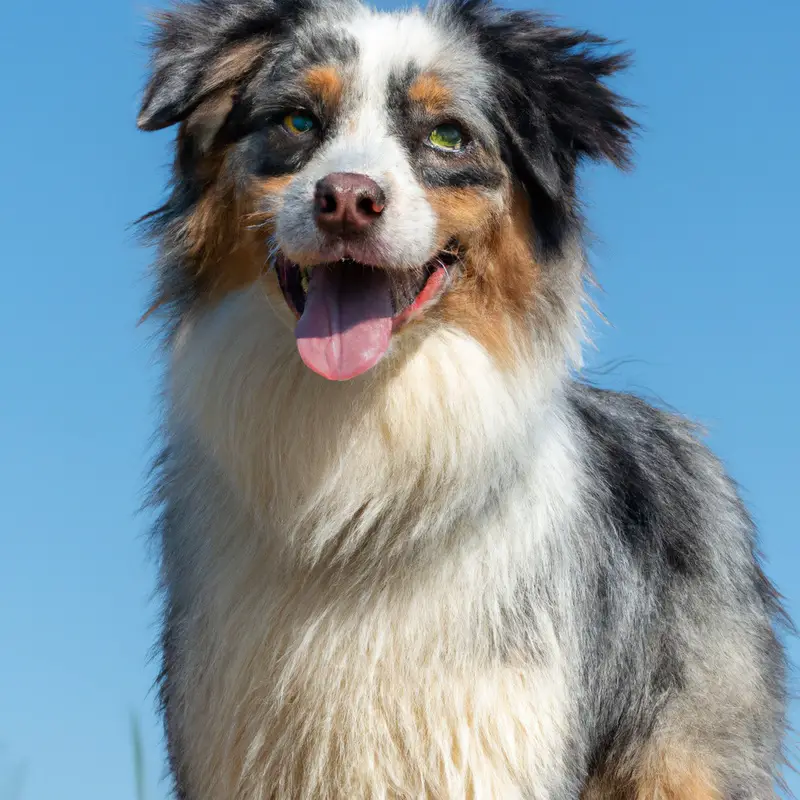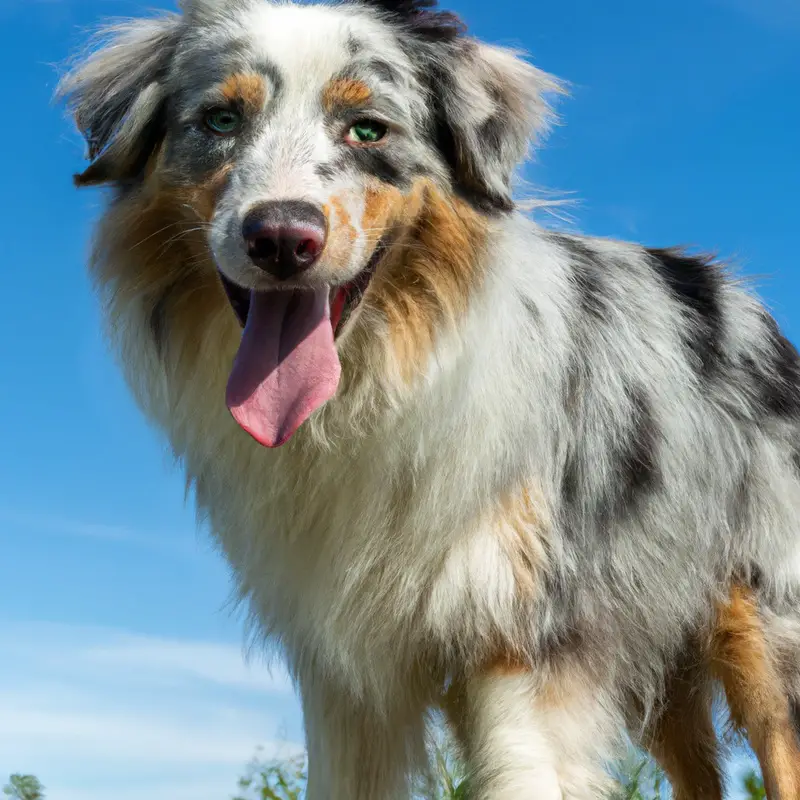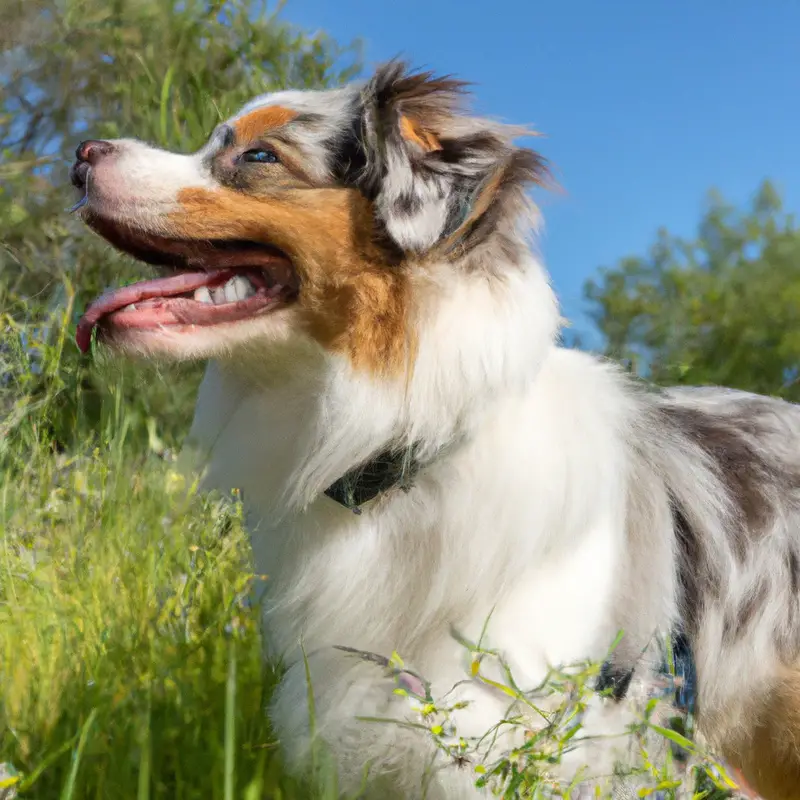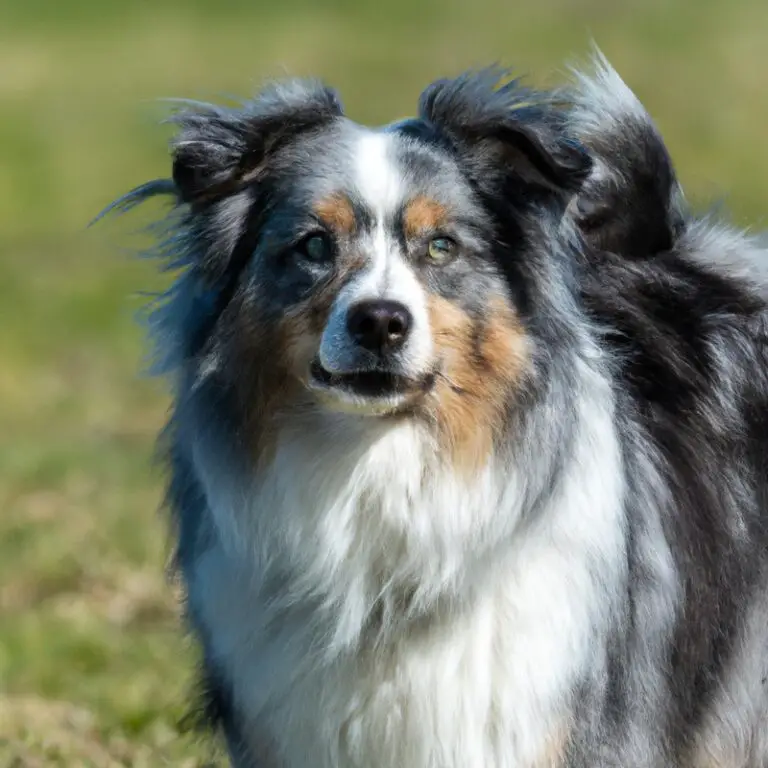How Do Australian Shepherds Handle Cold Weather?
Key Takeaways:
- Australian Shepherds have a thick double coat that helps them handle cold weather.
- They can adapt to colder climates, but they still need proper shelter and warm bedding.
- Physical activity and mental stimulation are crucial for their well-being in cold weather.
- Monitor their paws for signs of injury or damage from ice, salt, or cold surfaces.
Are Australian Shepherds born for snowball fights and winter wonderlands? As a self-proclaimed canine enthusiast and proud Australian Shepherd owner, I’m here to tell you all about how these magnificent pups handle the cold weather.
From their physical features and natural adaptability to the challenges they face in chilly climates, we’ll explore everything you need to know about Australian Shepherds in winter.
So grab a cup of cocoa, snuggle up with your furry friend, and let’s embark on this frosty adventure together!
| Factors | How Australian Shepherds Handle Cold Weather |
|---|---|
| 1. Coat | Australian Shepherds have a double coat that provides insulation and protection against cold temperatures. |
| 2. Size | They are medium-sized dogs with a sturdy build, which helps them retain body heat. |
| 3. Energy | Australian Shepherds are active and energetic dogs that generate body heat through exercise, helping them stay warm in cold weather. |
| 4. Adaptability | Although Australian Shepherds have a moderate tolerance to cold, they can adapt to colder temperatures with the right care and shelter. |
| 5. Shivering | When exposed to extremely low temperatures, Australian Shepherds may shiver to generate additional body heat. |
| 6. Access to Shelter | Providing a warm and insulated shelter for Australian Shepherds is important to protect them from extreme cold weather. |
| 7. Clothing | Using dog clothing, such as sweaters or coats, can provide extra warmth for Australian Shepherds in particularly cold conditions. |
Characteristics of Australian Shepherds
Physical features and coat type of Australian Shepherds
Australian Shepherds have unique physical features and a distinctive coat type that sets them apart from other dog breeds. They are medium-sized dogs with a well-balanced and muscular build.
One notable feature is their expressive and intelligent eyes, which come in shades of blue, amber, or brown.
The coat of an Australian Shepherd is dense and weather-resistant, designed to protect them from various elements. Their double coat consists of a thick, insulating undercoat and a longer, weatherproof outer coat.
Both the undercoat and outer coat help to keep them warm during colder temperatures.
The Australian Shepherd’s coat comes in a range of colors including black, red, blue merle, and red merle. They may also have copper or white markings on their face, chest, and legs.
The merle pattern adds a marbled or speckled appearance to their coat, making it aesthetically pleasing.
Regular grooming is essential to keep an Australian Shepherd’s coat healthy and free from mats or tangles. Brushing them two to three times a week helps to remove loose hair and prevent shedding.
However, during shedding seasons, which occur twice a year, more frequent brushing is required.
Overall, the physical features and coat type of Australian Shepherds make them well-suited to different climates, including colder weather. Their dense double coat provides insulation during chilly temperatures and protects them from rain or snow.
With proper grooming and care, Australian Shepherds can thrive in various environments while looking beautiful.

Natural adaptability to different climates
Australian Shepherds have a remarkable natural adaptability to different climates. This is due to their thick double coat, which helps to regulate their body temperature in both cold and hot weather conditions.
The undercoat acts as insulation to keep them warm in colder climates, while the outer coat helps to repel water and protect them from the elements.
Additionally, their coats also provide some level of sun protection in hotter climates. This adaptability allows Australian Shepherds to thrive in a variety of environments, making them suitable companions in different climates around the world.
Whether it’s snowy winters or scorching summers, Australian Shepherds can handle it all!

Cold weather challenges for Australian Shepherds
Australian Shepherds’ sensitivity to cold temperatures
Australian Shepherds have a moderate sensitivity to cold temperatures. While they have a dense double coat that provides insulation, they are more comfortable in milder climates.
When the weather turns cold, they may struggle to regulate their body temperature.
This can result in discomfort, decreased energy levels, and an increased risk of health issues like hypothermia or frostbite. It’s important to monitor them closely in cold weather and provide them with appropriate shelter, bedding, and winter wear to keep them warm and protected.
Risks and health issues related to cold weather exposure
Risks and health issues related to cold weather exposure for Australian Shepherds include hypothermia and frostbite. Hypothermia occurs when a dog’s body temperature drops too low, leading to shivering, lethargy, and even organ failure.
Frostbite, on the other hand, can affect the extremities, like the ears, paws, and tail.
It can cause tissue damage, pain, and infection. To prevent these risks, it’s essential to provide adequate shelter and ensure your Australian Shepherd has a warm, dry place to retreat to.
Using proper winter wear, such as a doggie jacket or boots, can also help protect them from the cold.
Adjusting their diet and providing plenty of fresh water is crucial, as dehydration can worsen the effects of cold weather. Regular exercise should be maintained, as it helps keep their bodies warm and their muscles active.
Additionally, grooming and coat care are important to keep their fur in good condition, as matted or wet fur offers less insulation.
Monitoring your Australian Shepherd for signs of frostbite or hypothermia is crucial. Symptoms may include pale or discolored skin, painful extremities, or excessive shivering.
If you notice any of these signs, it’s important to seek veterinary care promptly.
By being aware of the risks and taking appropriate measures, you can help keep your Australian Shepherd safe and healthy during cold weather.
Preparing Australian Shepherds for cold weather
Providing proper shelter and bedding
When it comes to providing proper shelter and bedding for Australian Shepherds in cold weather, there are a few key things to keep in mind. First, it’s important to provide a warm and insulated shelter for your dog, such as a doghouse or a heated garage.
Make sure the shelter is well-insulated and protected from drafts.
Inside the shelter, provide your Australian Shepherd with a warm and comfortable bed. This could be a thick blanket or a dog bed with extra padding.
Make sure the bed is elevated off the ground to prevent cold air from seeping in.
Consider using additional sources of warmth, such as heated pet mats or blankets, to keep your Australian Shepherd cozy during colder months. Just make sure to follow the manufacturer’s instructions and ensure the heating element is safe for pets.
Lastly, regularly check and clean your Australian Shepherd’s shelter and bedding to maintain cleanliness and prevent the buildup of dirt, moisture, or bacteria.
This will help to keep your dog healthy and comfortable in the cold weather.
Dressing Australian Shepherds with appropriate winter wear
To keep your Australian Shepherd comfortable and protected during cold weather, dressing them in appropriate winter wear is essential. Here are some tips for choosing the right attire:
- Consider the coat length: Australian Shepherds have a medium to long double coat, which provides insulation against the cold. Avoid dressing them in heavy coats that may overheat them. Opt for lighter, water-resistant jackets or sweaters that offer warmth without compromising their natural coat’s ability to regulate temperature.
- Pay attention to fit: Ensure that the winter wear fits your Australian Shepherd properly. It should be snug enough to stay in place but not restrictive or uncomfortable. Avoid clothing that covers their ears, as it may impair their hearing.
- Choose materials wisely: Look for winter wear made from insulating materials, such as fleece or wool, that can retain body heat. Avoid clothing with zippers, buttons, or excessive embellishments that may pose a choking hazard or create discomfort.
- Protect their paws: Australian Shepherds’ paws can be sensitive to cold surfaces and ice. Consider using booties or paw wax to protect their paws from cold temperatures and potential injuries from ice or salted roads.
- Layer up as needed: In extremely cold conditions, layering can provide extra warmth. Start with a lightweight, moisture-wicking base layer, followed by a well-fitting sweater or jacket. This allows for easy adjustments based on the temperature.
- Monitor their comfort: Pay attention to your Australian Shepherd’s behavior while they’re wearing winter clothing. Watch for signs of discomfort, such as excessive panting or scratching. If they seem too warm, remove a layer or choose lighter clothing.
Remember, every dog is different, so it’s essential to assess your Australian Shepherd’s individual needs and adjust accordingly. Dressing them in appropriate winter wear will help ensure their comfort and protection during colder months.
Adjusting diet and hydration during colder months
During colder months, it is important to adjust the diet and hydration of Australian Shepherds. I recommend increasing their calorie intake to help them generate more body heat.
This can be done by providing them with high-quality, nutrient-dense food that is specifically formulated for active dogs.
Additionally, it’s crucial to ensure that your Australian Shepherd has access to fresh and clean water at all times. Hydration is just as important in cold weather as it is in hot weather.
Consider using heated water bowls or insulating their regular water bowl to prevent it from freezing.
You may also want to supplement their diet with fatty acids, such as fish oil, to help maintain a healthy coat and skin during the dry winter months. This can help prevent itching and dryness.
Keep in mind that every dog is unique, so it’s a good idea to consult with a veterinarian to determine the specific dietary needs of your Australian Shepherd during the colder months.
They can provide personalized recommendations based on your dog’s age, activity level, and overall health. Remember to gradually adjust their diet and monitor their weight to ensure they are maintaining a healthy body condition.
By paying attention to their diet and hydration, you can help keep your Australian Shepherd happy, healthy, and comfortable during the colder months.
Maintaining Australian Shepherds’ well-being in cold weather
Regular exercise to keep them warm and active
Regular exercise is key to keeping Australian Shepherds warm and active during cold weather. By providing them with regular physical activity, their body temperature rises, helping them stay warm and comfortable.
Not only does exercise keep them physically fit, but it also stimulates their mind, warding off boredom and potential behavior problems.
Engaging in activities like brisk walks, interactive play sessions, or even indoor agility training can help keep your Australian Shepherd active and happy, even when the weather outside is cold.

Importance of grooming and coat care
Grooming and coat care are essential for Australian Shepherds, especially in cold weather. Regular brushing helps to remove dirt, debris, and tangles from their thick double coat, preventing matting and skin issues.
It also stimulates blood circulation and distributes natural oils, keeping their coat healthy and shiny.
Trimming the hair around their paws and ears helps to prevent ice balls and infections. Additionally, grooming sessions allow you to check for any skin abnormalities or parasites.
Bathing should be done as needed, using a gentle dog shampoo that doesn’t dry out their skin.
Overall, proper grooming and coat care contribute to the well-being and comfort of Australian Shepherds in cold weather.
Monitoring for signs of frostbite or hypothermia
Monitoring for signs of frostbite or hypothermia is crucial to ensure the well-being of Australian Shepherds in cold weather. It’s important to keep an eye on your dog’s behavior, as well as physical signs that may indicate these conditions.
Signs of frostbite include pale or gray skin, blisters, and a lack of sensitivity in the affected area.
Hypothermia, on the other hand, may present with shivering, lethargy, weak pulse, and disorientation. Regularly checking your Australian Shepherd’s body temperature can also help detect potential issues.
If you notice any of these signs, it’s important to seek veterinary care immediately to prevent further complications.
Additional tips for Australian Shepherds in cold climates
Training and mental stimulation during indoor days
When you’re stuck indoors with your Australian Shepherd on cold days, training and mental stimulation become vital. These intelligent and active dogs need to stay engaged to prevent boredom and destructive behaviors.
To keep your Aussie’s mind sharp, try incorporating short training sessions throughout the day.
Teach them new commands or work on reinforcing existing ones. Remember to use positive reinforcement techniques, such as treats and praise, to keep them motivated.
Mental stimulation can also come in the form of interactive toys and puzzles.
These can challenge your Australian Shepherd’s problem-solving skills and keep them occupied. You can find a variety of toys designed to dispense treats or hide objects for your dog to discover.
Another great way to engage your Aussie indoors is through interactive playtime.
Games like hide-and-seek or tug-of-war can provide mental stimulation while also burning off some energy. Consider setting up obstacle courses or creating indoor agility exercises.
This not only keeps your Australian Shepherd physically active but also requires them to think and problem-solve as they navigate the course.
Lastly, don’t forget to give your Aussie plenty of love and attention during indoor days. Spend quality time with them, cuddle, and engage in gentle interactive activities like grooming or massage.
These bonding moments are essential for their overall well-being.
By focusing on training and mental stimulation during indoor days, you can ensure that your Australian Shepherd remains happy, fulfilled, and well-behaved even when the weather keeps you indoors.
Considering alternative exercise options when outdoor activities are limited
When the weather is too harsh for outdoor activities, there are still plenty of ways to keep your Australian Shepherd active and engaged. Here are some alternative exercise options to consider:
- Indoor games: Engage your Australian Shepherd in mental stimulation games like hide and seek, puzzle toys, or treat dispensing toys. These activities will challenge their intelligence and keep them entertained.
- Obedience training: Spend time indoors working on obedience training. Australian Shepherds love learning new commands and tricks, and this will not only keep them physically active but also strengthen your bond with them.
- Tug-of-war: Playing a game of tug-of-war with your Australian Shepherd is a great way to provide them with physical exercise. Just make sure to establish some rules and boundaries to avoid any excessive roughness.
- Fetch in the house: Clear a safe area in your home and play a game of indoor fetch with your Australian Shepherd. Use soft toys or balls that won’t cause any damage. This game will keep them moving and burn off some energy.
- Doggy treadmill: If you have access to a doggy treadmill, it can be a wonderful tool for keeping your Australian Shepherd active when outdoor activities are limited. Start slow and gradually increase the intensity and duration of their workout.
Remember, it’s important to monitor your Australian Shepherd’s energy levels and adjust these activities accordingly. Keep them mentally and physically engaged, even during times when outdoor activities are not possible.
Utilizing toys and puzzles for mental stimulation
When it comes to keeping your Australian Shepherd mentally stimulated in colder weather, utilizing toys and puzzles can be a great option. These activities help prevent boredom and keep their minds sharp.
Toys that require problem-solving, like treat-dispensing puzzles or interactive toys, are ideal for mental stimulation.
They challenge your Australian Shepherd to figure out how to access the treats or solve the puzzle, keeping their minds engaged and active. You can also try hide-and-seek games with toys or treats.
Hide them around your home and encourage your Australian Shepherd to find them.
This game not only provides mental stimulation but also gets them moving and exploring. Interactive toys that make noise or require your dog to figure out how to operate them can also be engaging.
They encourage curiosity and problem-solving, stimulating your Australian Shepherd’s cognitive abilities.
Rotate the toys and puzzles you provide to keep things interesting. Introduce new ones periodically to prevent boredom.
This will keep your Australian Shepherd engaged and entertained, even when outdoor activities are limited.
Remember, mental stimulation is just as important as physical exercise for your Australian Shepherd’s well-being. By incorporating toys and puzzles into their daily routine, you can help keep them mentally sharp and happy, regardless of the weather outside.
Final Verdict
Australian Shepherds possess unique characteristics that enable them to handle cold weather with proper care and preparation. Their physical features and adaptable nature contribute to their ability to withstand lower temperatures.
However, it is essential to address the potential challenges they may face, including sensitivity to cold and health risks.
By providing appropriate shelter, dressing them with winter wear, adjusting their diet, and maintaining exercise and grooming routines, Australian Shepherds can thrive in colder climates. Remember to monitor their well-being and provide mental stimulation during indoor days.
With these considerations, Australian Shepherds can comfortably navigate the colder months.








